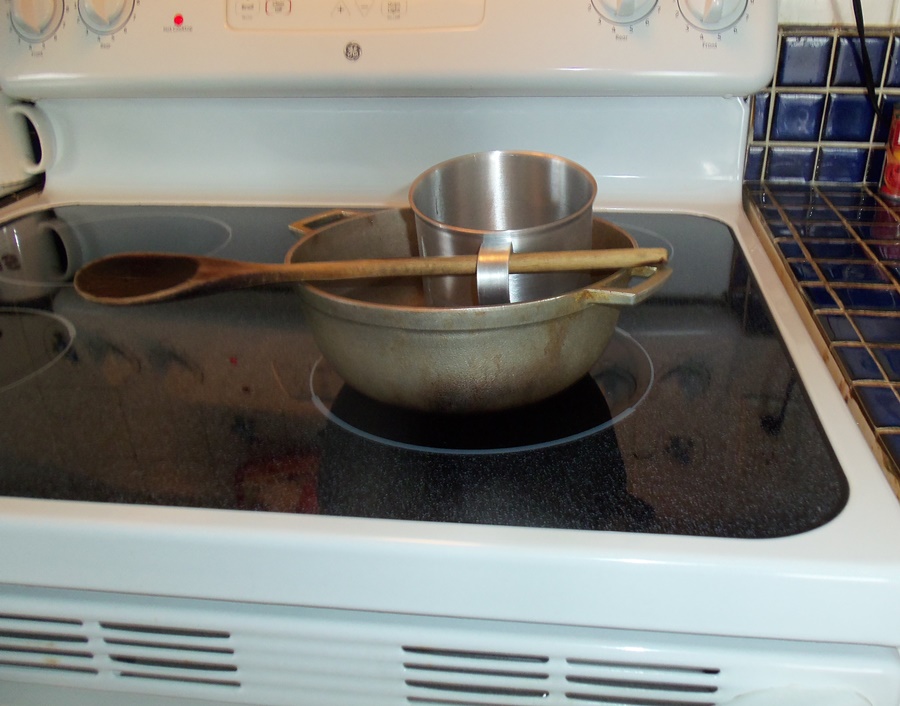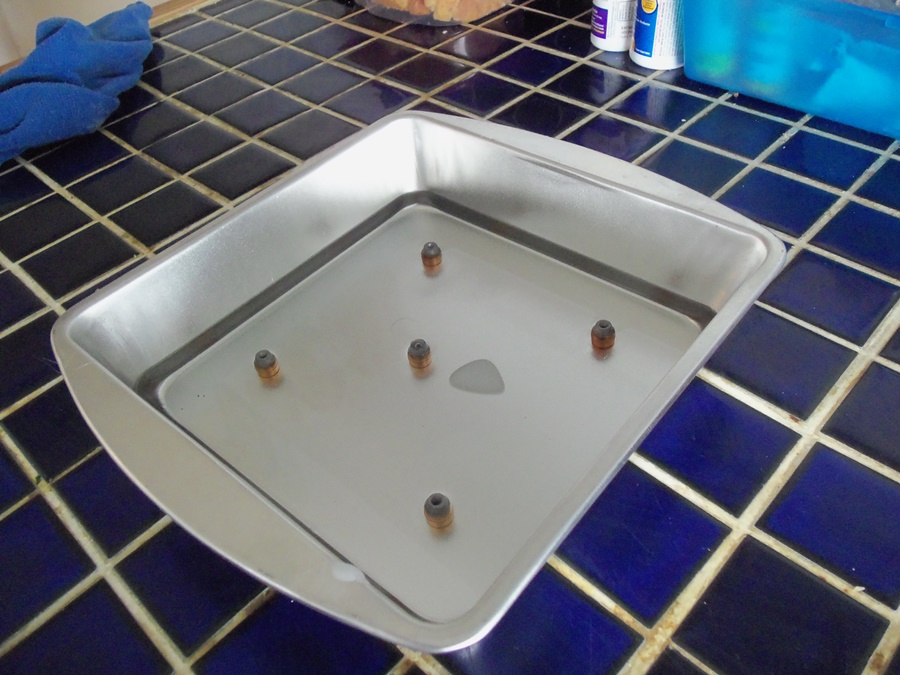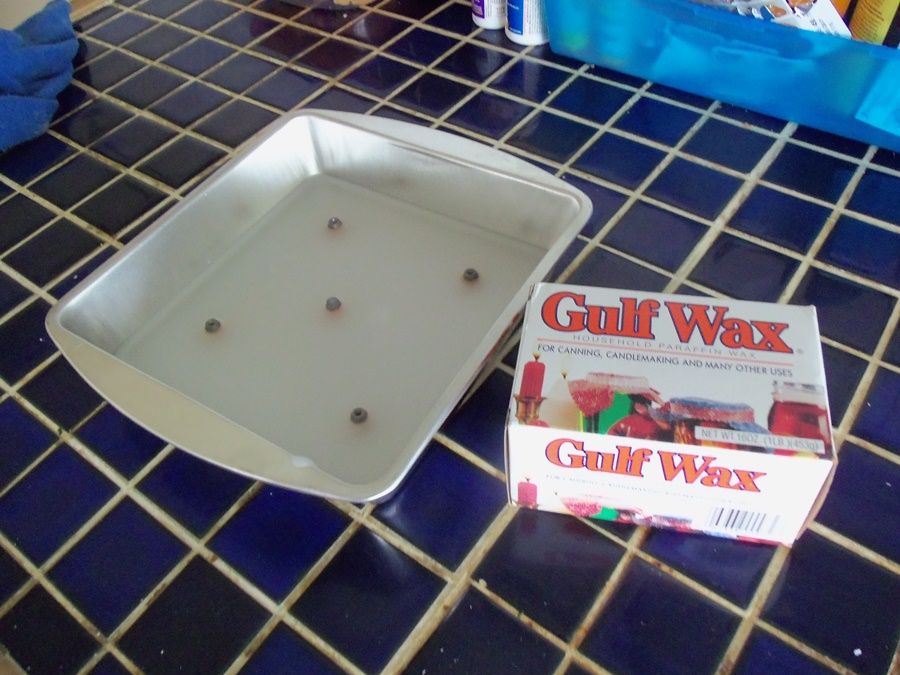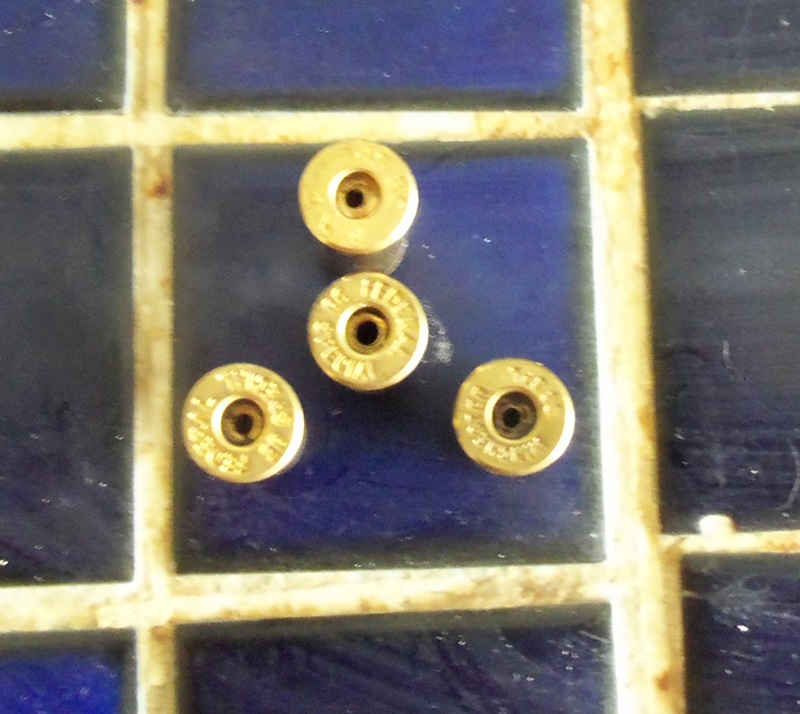So instead of doing what I was supposed to be doing today, I went ahead and tackled the wax bullet cartridges. I more or less followed the instruction from the America Rifleman that I posted before but not quite.
The materials are quite cheap. Got the pan and the cup from Walmart under $5, the wax was about $7 for one pound , the cases I already had (range pick ups) and primers bought before the craze.
Started with melting the paraffin wax doing the double boil thing.
 I did half a pound of wax on low medium as I did not know and did not want to know what would happen if paraffin suddenly boiled and touched water. Having the experience of knowing what happens when water touches molten lead has left me very wary and careful.
I did half a pound of wax on low medium as I did not know and did not want to know what would happen if paraffin suddenly boiled and touched water. Having the experience of knowing what happens when water touches molten lead has left me very wary and careful.
Next, I poured the wax in an 8 x 8 pan:
 Those are .38 special HP bullets that I used to determine the thickness required. The article said that about half an inch was good and those bullets are just a wee over that.
Those are .38 special HP bullets that I used to determine the thickness required. The article said that about half an inch was good and those bullets are just a wee over that.
 The wax starting to harden. That was the brand I bought and it was very clear when molten. By the reviews, apparently it is one of the best in the market.
The wax starting to harden. That was the brand I bought and it was very clear when molten. By the reviews, apparently it is one of the best in the market.
While waiting for the paraffin to harden, I went ahead and expanded the flash holes of the .38 special cases I was going to use. Again, on the article it says to use a 3/32 drill bit and amazingly I had one available! I selected 16 cases that got resized and de-capped.
 The one in the middle is expanded and the other three are factory size so you can compare.
The one in the middle is expanded and the other three are factory size so you can compare.
Next came the seating of the “waxcutter” bullet.
 And no, just driving the case with your thumb ain’t gonna do it. I had to use a small plastic mallet and tapped gently till it reached the bottom. Twist the case and the “waxcutter” will release the pan without issue.
And no, just driving the case with your thumb ain’t gonna do it. I had to use a small plastic mallet and tapped gently till it reached the bottom. Twist the case and the “waxcutter” will release the pan without issue.
Next, primer installation.
 Nothing fancy, just seat the primer with your choice of tool and you are set.
Nothing fancy, just seat the primer with your choice of tool and you are set.
Next was the test. The noise is about half to 1/3 of those cheap firecrakers sold on the Fourth July (Black Cat?) I put four out of five rounds in a cardboard box at 10 feet and here are the results:
 The bottom one was the first test inside the house with the box placed against a safe at about 4 feet. The other four were outside at 10 feet.
The bottom one was the first test inside the house with the box placed against a safe at about 4 feet. The other four were outside at 10 feet.
 As you can see, the babies remained inside the box. That is one…two…three and….
As you can see, the babies remained inside the box. That is one…two…three and….
The “waxcutters” were shot out of a Rossy Snub Nose revolver but I will upgrade to my 4 inch S&W 65 tomorrow.
Now, are they dangerous? Anything coming out of the barrel of a firearm is implicitly dangerous. Of course the level of damage cannot be compared to a real lead bullet, but embedding itself in cardboard is not a gentle caress. So, if you are planning on duplicating this recipe, no butt-shooting your roommate as it will probably leave a very nasty bruise and probably skin breaking.
Summary: Wax bullets (waxcutters) are easy to make (From saying “Let’s do this” to last shot fire, it took me less than an hour,) fun to shoot and probably an easy continuation to the dry-fire exercises.
You may want to think about it.


That looks like EXCELLENT fun. I have a feeling it would make people in my apartment building rather cross, though.
I wonder if Waxcutters count as live ammunition when testing students at the range for the basic pistol course. I can think of a few that would have benefited from low recoil and no hearing protection for their first shots. Not yelling over the ear protection at a nervous woman holding a loaded firearm for the first time would be safer for me.
For NRA classes, it is not valid.
I’ve never tried wax bullets but I have used some cast from hot glue in regular bullet molds. They seem to perform about the same and you can usually reuse them a time or two. Might have to try the wax ones out.
Lantry, this way is less work. On pan-full of wax is good for a bunch of boolits
You need to mark the cases that have enlarged flash holes so that they will never be reloaded with standard loads. That is dangerous!
That is why I referred to the original article….
Will they cycle my AR? …jk…
[…] Go to this article […]
Jim — If you’re teaching regularly, it might well be worth it to set up a .22 with a suppressor. .22LR counts for Basic Pistol Course, right? If not, you could have that as an add-on to teh course, to slowly work some of the more gunshy students up to a centerfire pistol. . .
What a handy, interesting article. I’m going to try this as soon as I can!
How safe are these to shoot inside (with normal house ventilation)? What, if anything, in the priming compound may cause concern? Lead maybe?
Also, anybody know if this is considered ‘discharging a firearm’ in the legal sense?
How safe are these to shoot inside (with normal house ventilation)?
I don’t think nothing bad that a couple of open windows would mend as the dosage you may get is small.
Also, anybody know if this is considered ‘discharging a firearm’ in the legal sense?
Bet your bippy it is, then again the detonation is about as hard as a handclap so unless you happen to have a cop peering through your window, I don’t think it is an issue. Check your local laws.